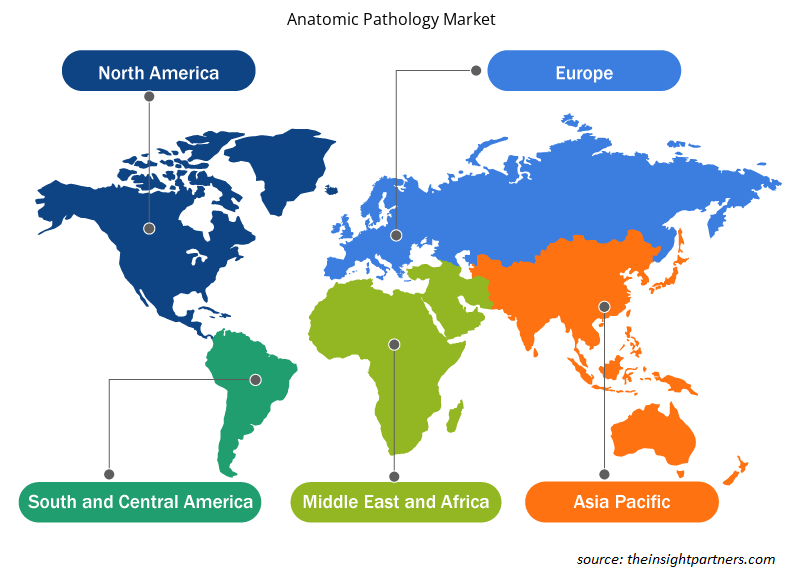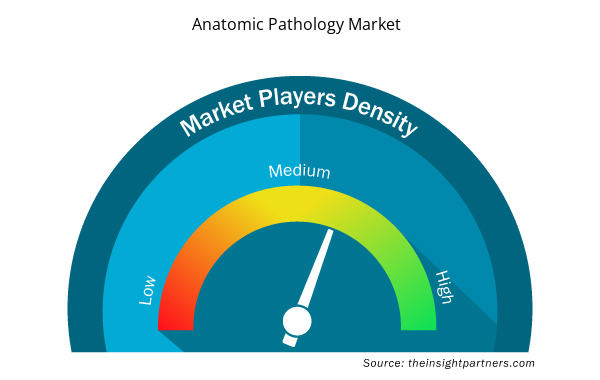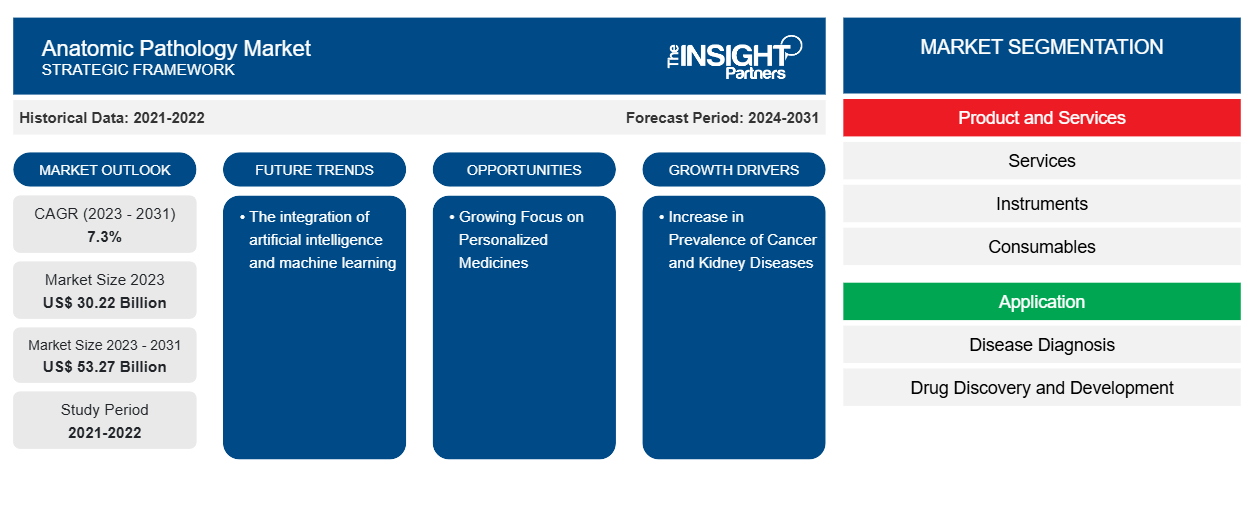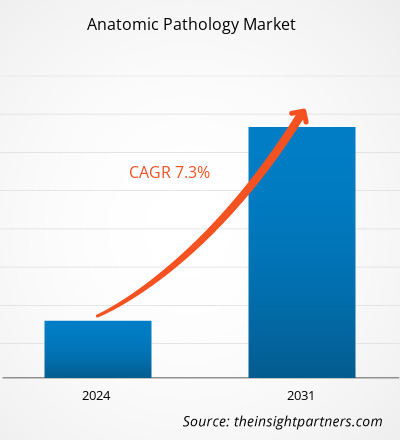من المتوقع أن يصل حجم سوق علم الأمراض التشريحي إلى 53.27 مليار دولار أمريكي بحلول عام 2031 من 30.22 مليار دولار أمريكي في عام 2023. ومن المتوقع أن يسجل السوق معدل نمو سنوي مركب بنسبة 7.3٪ خلال الفترة 2023-2031. ومن المرجح أن يعمل دمج الذكاء الاصطناعي والتعلم الآلي كتوجه مستقبلي في السوق.
تحليل سوق علم الأمراض التشريحي
إن الابتكارات في تقنيات التشخيص - بما في ذلك علم الأمراض الرقمي والتشخيص الجزيئي وتقنيات التصوير - تعمل على تعزيز دقة وكفاءة خدمات علم الأمراض، مما يدفع نمو سوق علم الأمراض التشريحي . إن السكان المسنين أكثر عرضة للإصابة بأمراض مختلفة، مما يؤدي إلى زيادة الطلب على خدمات علم الأمراض من أجل التشخيص الدقيق والتخطيط للعلاج. بالإضافة إلى ذلك، فإن زيادة الوعي بالقضايا الصحية، وبرامج الفحص القوية التي تساهم في التشخيص المبكر، والأطر التنظيمية الداعمة، وسياسات السداد المواتية تعمل على تغذية نمو سوق علم الأمراض التشريحي.
نظرة عامة على سوق علم الأمراض التشريحي
من المتوقع أن تسجل الهند أعلى معدل نمو سنوي مركب في السوق الإجمالية. وتوقع تقرير برنامج السجل الوطني للسرطان لعام 2020 أن تصل حالات الإصابة بالسرطان في الهند إلى 14.61 مليون حالة في عام 2022. وذكر التقرير أيضًا أن معدل الإصابة بالسرطان من المتوقع أن يزيد بنسبة 12.8٪ بحلول عام 2025 مقارنة بعام 2020. مع انتشار السرطان المتزايد والتقدم في البنية التحتية للرعاية الصحية، تركز السلطات الحكومية في الهند على تزويد الناس بإمكانية الوصول إلى حلول الرعاية الصحية الموسعة. وفقًا لبيانات وزارة تعزيز الصناعة والتجارة الداخلية (DPIIT)، بلغ إجمالي تدفق الاستثمارات الأجنبية المباشرة (FDIs) إلى صناعة الأدوية والمستحضرات الصيدلانية 17.74 مليار دولار أمريكي من أبريل 2000 إلى ديسمبر 2020. علاوة على ذلك، تقوم الشركات والمنظمات والحكومات وما إلى ذلك باستثمارات كبيرة في الخدمات التشخيصية ومرافق التشخيص الحديثة . وبالتالي، فإن مثل هذه الاستثمارات في قطاع الرعاية الصحية تعزز نمو سوق علم الأمراض التشريحي في الهند.
قم بتخصيص هذا التقرير ليناسب متطلباتك
ستحصل على تخصيص لأي تقرير - مجانًا - بما في ذلك أجزاء من هذا التقرير، أو تحليل على مستوى الدولة، وحزمة بيانات Excel، بالإضافة إلى الاستفادة من العروض والخصومات الرائعة للشركات الناشئة والجامعات
- احصل على أهم اتجاهات السوق الرئيسية لهذا التقرير.ستتضمن هذه العينة المجانية تحليلاً للبيانات، بدءًا من اتجاهات السوق وحتى التقديرات والتوقعات.
محركات وفرص سوق علم الأمراض التشريحي
ارتفاع معدلات الإصابة بالسرطان وأمراض الكلى
علم الأمراض التشريحي مفيد في تحديد التشوهات التي يمكن أن تساعد في تشخيص الأمراض، مثل أمراض المناعة الذاتية وأمراض الكلى والكبد والسرطان. علم الأمراض النسيجي، الذي يتضمن دراسة التغيرات في الأنسجة الناجمة عن الأمراض، هو جزء حيوي من علم الأمراض التشريحي. للسرطان تأثير كبير على المجتمع في جميع أنحاء العالم. يتزايد عبء السرطان على أنظمة الرعاية الصحية بشكل كبير في جميع أنحاء العالم لأنه من بين الأسباب الرئيسية للوفاة. تصنف منظمة الصحة العالمية السرطان باعتباره ثاني سبب رئيسي للوفاة في جميع أنحاء العالم. وفقًا للبيانات التي نشرها صندوق أبحاث السرطان العالمي الدولي، تم تسجيل حوالي 20 مليون حالة إصابة جديدة بالسرطان في عام 2022 على مستوى العالم. علاوة على ذلك، وفقًا للبيانات التي نشرتها منظمة الصحة العالمية، كان سبب ما يقرب من 10 ملايين حالة وفاة في جميع أنحاء العالم بسبب السرطان في عام 2020. تقدر بيانات المركز الوطني لإحصاءات الصحة أن تشخيص حالات السرطان الجديدة في الولايات المتحدة من المرجح أن يصل إلى 2 مليون في عام 2024. بالإضافة إلى ذلك، من المرجح أن يموت حوالي 0.61 مليون شخص في عام 2024 في الولايات المتحدة بسبب السرطان. وفقًا للبيانات التي نشرتها مؤسسة ماكميلان لدعم مرضى السرطان، يتم تشخيص إصابة حوالي 392 ألف شخص بالسرطان في المملكة المتحدة كل عام، بينما يموت حوالي 167 ألف شخص بسبب المرض كل عام.
يتزايد انتشار أمراض الكلى المزمنة بسبب الزيادة في عدد السكان المسنين. وفقًا لمراكز السيطرة على الأمراض والوقاية منها، في عام 2023، عانى حوالي 35.5 مليون شخص في الولايات المتحدة من أمراض الكلى المزمنة. تُستخدم الخزعة، وهي تقنية علم الأمراض التشريحية، للكشف عن السرطان وأمراض الكلى المزمنة. ونظرًا للانتشار المتزايد للسرطان وأمراض الكلى، فإن الوكالات الحكومية ومقدمي الرعاية الصحية والمؤسسات مضطرة إلى المساهمة في مبادرات تشخيص المرض وعلاجه. وبالتالي، فإن الارتفاع في انتشار السرطان والأمراض المستهدفة الأخرى، مثل أمراض المناعة الذاتية وأمراض الكلى والكبد، يدفع نمو سوق علم الأمراض التشريحي العالمي.
التركيز المتزايد على الأدوية المخصصة للمرضى من شأنه أن يوفر فرصًا للسوق
إن تصميم الأدوية الشخصية يتم بشكل أساسي من خلال مراعاة السمات الوراثية للأفراد لتوجيه القرارات المتخذة فيما يتعلق بالوقاية من الأمراض وتشخيصها وعلاجها. وهي توفر فرصة لمصنعي الأدوية لتطوير عوامل تستهدف مجموعات المرضى الذين لا يستجيبون للأدوية على النحو المقصود أو الذين لا يستجيبون كما هو متوقع لممارسات الرعاية الصحية التقليدية. هناك الكثير من الأدلة التي تشير إلى أن جزءًا كبيرًا من التباين في استجابة الأدوية يعتمد على عوامل يتم التحكم فيها وراثيًا، بما في ذلك العمر والتغذية والتعرض البيئي والحالة الصحية. تلعب الجينوميات دورًا مهمًا في ظهور الأدوية الشخصية، حيث أن معرفة السمات الوراثية للمريض من شأنها أن تساعد الأطباء في اختيار الدواء المناسب. الأدوية الشخصية مفيدة في تحسين الرعاية الصحية من خلال تمكين كل مريض من تلقي التشخيصات المبكرة وتقييم المخاطر والعلاجات المثلى.
يلعب علماء الأمراض دورًا مهمًا في تطوير وتنفيذ الاختبارات الجزيئية والجينومية في الممارسة العملية. تُستخدم الأدوية المخصصة في علاج أمراض مثل سرطان الثدي وأمراض القلب والأوعية الدموية. تظهر الأدوية المضادة للسرطان المخصصة آثارًا جانبية أقل وأقل حدة من أنواع العلاج الأخرى لأنها مصممة لإجراء أكثر تحديدًا. علاوة على ذلك، مع التقدم المستمر في البحث والدراسات السريرية، من المرجح أن تصل الأدوية المخصصة إلى إمكانات أكبر لتحسين جودة رعاية المرضى. وبالتالي، من المتوقع أن يعزز التركيز المتزايد على الأدوية المخصصة نمو سوق علم الأمراض التشريحي.
تحليل تجزئة تقرير سوق علم الأمراض التشريحي
القطاعات الرئيسية التي ساهمت في استخلاص تحليل سوق علم الأمراض التشريحي هيالمنتجات والخدمات، والتطبيقات، والمستخدم النهائي.
- بناءً على المنتجات والخدمات، يتم تقسيم سوق علم الأمراض التشريحي إلى أدوات ومواد استهلاكية وخدمات. وينقسم قطاع الخدمات إلى علم الأمراض النسيجية وعلم الأمراض الخلوية. وينقسم قطاع الأدوات إلى أجهزة الميكروتوم وأجهزة التبريد، وأجهزة الصبغ الأوتوماتيكية، ومعالجات الأنسجة، وغيرها. وقد احتل قطاع الأدوات أكبر حصة في السوق في عام 2023.
- من حيث التطبيق، يتم تقسيم السوق إلى تشخيص الأمراض واكتشاف الأدوية وتطويرها وغيرها. احتل قطاع تشخيص الأمراض الحصة الأكبر في السوق في عام 2023.
- بناءً على المستخدم النهائي، ينقسم سوق علم الأمراض التشريحي إلى المستشفيات ومختبرات الأبحاث ومختبرات التشخيص وغيرها. احتل قطاع المستشفيات الحصة الأكبر في السوق في عام 2023.
تحليل حصة سوق علم الأمراض التشريحي حسب المنطقة الجغرافية
ينقسم النطاق الجغرافي لتقرير سوق علم الأمراض التشريحي بشكل أساسي إلى خمس مناطق: أمريكا الشمالية، وآسيا والمحيط الهادئ، وأوروبا، وأمريكا الجنوبية والوسطى، والشرق الأوسط وأفريقيا. سيطرت أمريكا الشمالية على السوق في عام 2023. ويعزى نمو السوق في هذه المنطقة إلى الانتشار المتزايد للسرطان، وزيادة المبادرات الحكومية لفحص مرضى السرطان، والتركيز المتزايد على التشخيص الفعال للمرض، والحاجة المتزايدة إلى أنظمة الرعاية الصحية المتقدمة. علاوة على ذلك، من المرجح أن تؤدي زيادة جهود البحث والتطوير التي يقوم بها اللاعبون في السوق، إلى جانب إطلاق المنتجات، إلى دفع نمو سوق علم الأمراض التشريحي في أمريكا الشمالية خلال فترة التنبؤ. يركز اللاعبون العاملون في سوق علم الأمراض التشريحي في الولايات المتحدة باستمرار على تطوير أدوات ومواد استهلاكية مبتكرة ومريحة للإجراءات المرضية. في نوفمبر 2023، قدمت شركة Illumina Inc.، الولايات المتحدة، وهي شركة عالمية رائدة في تقنيات تسلسل الحمض النووي والتقنيات القائمة على المصفوفات، TruSight Oncology 500 ctDNA v2 (رقم اللوحة 1 ctDNA v2)، وهي نسخة جديدة من اختبار خزعة السائل الموزع الذي يسمح بالتحليل الجينومي الشامل غير الجراحي للحمض النووي للورم الدائر من الدم، مكملاً للاختبار القائم على الأنسجة. ومن المتوقع أن تسجل منطقة آسيا والمحيط الهادئ أعلى معدل نمو سنوي مركب خلال فترة التنبؤ.
رؤى إقليمية حول سوق علم الأمراض التشريحي
لقد قام المحللون في Insight Partners بشرح الاتجاهات والعوامل الإقليمية المؤثرة على سوق علم الأمراض التشريحي طوال فترة التوقعات بشكل شامل. يناقش هذا القسم أيضًا قطاعات سوق علم الأمراض التشريحي والجغرافيا في جميع أنحاء أمريكا الشمالية وأوروبا ومنطقة آسيا والمحيط الهادئ والشرق الأوسط وأفريقيا وأمريكا الجنوبية والوسطى.

- احصل على البيانات الإقليمية المحددة لسوق علم الأمراض التشريحي
نطاق تقرير سوق علم الأمراض التشريحي
| سمة التقرير | تفاصيل |
|---|---|
| حجم السوق في عام 2023 | 30.22 مليار دولار أمريكي |
| حجم السوق بحلول عام 2031 | 53.27 مليار دولار أمريكي |
| معدل النمو السنوي المركب العالمي (2023 - 2031) | 7.3% |
| البيانات التاريخية | 2021-2022 |
| فترة التنبؤ | 2024-2031 |
| القطاعات المغطاة | حسب المنتج والخدمات
|
| المناطق والدول المغطاة | أمريكا الشمالية
|
| قادة السوق وملفات تعريف الشركات الرئيسية |
|
كثافة اللاعبين في السوق: فهم تأثيرها على ديناميكيات الأعمال
يشهد سوق علم الأمراض التشريحي نموًا سريعًا، مدفوعًا بالطلب المتزايد من المستخدم النهائي بسبب عوامل مثل تفضيلات المستهلك المتطورة والتقدم التكنولوجي والوعي المتزايد بفوائد المنتج. ومع ارتفاع الطلب، تعمل الشركات على توسيع عروضها والابتكار لتلبية احتياجات المستهلكين والاستفادة من الاتجاهات الناشئة، مما يؤدي إلى زيادة نمو السوق.
تشير كثافة اللاعبين في السوق إلى توزيع الشركات أو المؤسسات العاملة في سوق أو صناعة معينة. وهي تشير إلى عدد المنافسين (اللاعبين في السوق) الموجودين في مساحة سوق معينة نسبة إلى حجمها أو قيمتها السوقية الإجمالية.
الشركات الرئيسية العاملة في سوق علم الأمراض التشريحي هي:
- شركة ف. هوفمان-لاروش المحدودة
- شركة بيكمان كولتر
- شركة هولوجيك
- شركة اجيلنت للتكنولوجيا
- مختبرات بيوجينكس
- دياباث سبا
إخلاء المسؤولية : الشركات المذكورة أعلاه ليست مرتبة بأي ترتيب معين.

- احصل على نظرة عامة على أهم اللاعبين الرئيسيين في سوق علم الأمراض التشريحي
أخبار سوق علم الأمراض التشريحي والتطورات الأخيرة
يتم تقييم سوق علم الأمراض التشريحي من خلال جمع البيانات النوعية والكمية بعد البحث الأولي والثانوي، والتي تتضمن منشورات الشركات المهمة وبيانات الجمعيات وقواعد البيانات. فيما يلي بعض التطورات في السوق:
- أبرمت شركة Agilent Technologies Inc. شراكة مع شركة Hamamatsu Photonics KK، وهي شركة رائدة في توفير أنظمة تصوير الشرائح الكاملة. وتضمن التعاون دمج مجموعة NanoZoomer من Hamamatsu، بما في ذلك نظام الماسح الضوئي S360MD Slide، في حل علم الأمراض الرقمي من Agilent. وقد أدى إضافة أنظمة الماسح الضوئي NanoZoomer Slide، التي تحول الشرائح الزجاجية إلى بيانات رقمية عالية الدقة من خلال المسح الضوئي عالي السرعة، إلى إكمال عرض Agilent لتدفق عمل علم الأمراض الرقمي المفتوح والمحايد الذي يهدف إلى تسريع الاختراقات في الطب الدقيق. (المصدر: موقع شركة Agilent Technologies Inc.، مارس 2023)
- أعلنت شركة Epredia، وهي شركة تابعة لشركة PHC Corporation، وشركة NovaScan، Inc.، وهي شركة تعمل على تطوير تكنولوجيا رائدة للكشف عن السرطان وتصنيفه، عن توقيع خطاب نوايا لاتفاقية توزيع تجاري حصرية في الولايات المتحدة لجهاز MarginScan، وهو جهاز طبي سيدعم الأطباء في الكشف في الوقت الفعلي عن سرطان الجلد غير الميلانيني. وقد تعاقدت شركة Epredia مع شركة Avantik، وهي شركة متخصصة في دعم المختبرات التشخيصية في عملياتها، لتوصيل هذا الجهاز الجديد إلى أيدي جراحي Mohs. (المصدر: شركة PHC Corporation، موقع الشركة على الويب، مايو 2024)
تغطية تقرير سوق علم الأمراض التشريحي والمنتجات النهائية
يوفر تقرير "حجم سوق علم الأمراض التشريحي والتوقعات (2021-2031)" تحليلاً مفصلاً للسوق يغطي المجالات التالية:
- حجم سوق علم الأمراض التشريحي وتوقعاته على المستويات العالمية والإقليمية والوطنية لجميع قطاعات السوق الرئيسية التي يغطيها النطاق
- اتجاهات سوق علم الأمراض التشريحي، بالإضافة إلى ديناميكيات السوق مثل المحركات والقيود والفرص الرئيسية
- تحليل مفصل لـ PEST و SWOT
- تحليل سوق علم الأمراض التشريحي الذي يغطي اتجاهات السوق الرئيسية والإطار العالمي والإقليمي واللاعبين الرئيسيين واللوائح والتطورات الأخيرة في السوق
- تحليل المشهد الصناعي والمنافسة الذي يغطي تركيز السوق، وتحليل خريطة الحرارة، واللاعبين البارزين، والتطورات الأخيرة لسوق علم الأمراض التشريحي
- ملفات تعريف الشركة التفصيلية
- التحليل التاريخي (سنتان)، السنة الأساسية، التوقعات (7 سنوات) مع معدل النمو السنوي المركب
- تحليل PEST و SWOT
- حجم السوق والقيمة / الحجم - عالميًا وإقليميًا وقطريًا
- الصناعة والمنافسة
- مجموعة بيانات Excel


- Latent TB Detection Market
- Skin Tightening Market
- Micro-Surgical Robot Market
- Artificial Intelligence in Defense Market
- Saudi Arabia Drywall Panels Market
- Human Microbiome Market
- Visualization and 3D Rendering Software Market
- Resistance Bands Market
- Virtual Pipeline Systems Market
- Portable Power Station Market

Report Coverage
Revenue forecast, Company Analysis, Industry landscape, Growth factors, and Trends

Segment Covered
This text is related
to segments covered.

Regional Scope
North America, Europe, Asia Pacific, Middle East & Africa, South & Central America

Country Scope
This text is related
to country scope.
الأسئلة الشائعة
The anatomic pathology market value is expected to reach US$ 53.27 billion by 2031.
The market is expected to register a CAGR of 7.3% during 2023–2031.
The services segment dominated the global anatomic pathology market and held the largest revenue share of 40.04% in 2021.
F. Hoffmann-La Roche Ltd, Beckman Coulter Inc, Hologic Inc, Agilent Technologies Inc, BioGenex Laboratories Inc, Diapath S.p.A., Bio SB, Merck KGaA, BD, and PHC Holdings Corporation are among the key players in the market.
The integration of artificial intelligence and machine learning is expected to be a prime trend in the market in the coming years.
North America dominated the market in 2023.
The increase in the prevalence of cancer and kidney diseases and the rise in the number of strategic initiatives are among the most significant factors fueling the market growth.
The List of Companies - Anatomic Pathology Market
- F. Hoffmann-La Roche Ltd
- Beckman Coulter Inc
- Hologic Inc
- Agilent Technologies Inc
- BioGenex Laboratories Inc
- Diapath S.p.A.
- Bio SB
- Merck KGaA
- BD
- PHC Holdings Corporation
The Insight Partners performs research in 4 major stages: Data Collection & Secondary Research, Primary Research, Data Analysis and Data Triangulation & Final Review.
- Data Collection and Secondary Research:
As a market research and consulting firm operating from a decade, we have published and advised several client across the globe. First step for any study will start with an assessment of currently available data and insights from existing reports. Further, historical and current market information is collected from Investor Presentations, Annual Reports, SEC Filings, etc., and other information related to company’s performance and market positioning are gathered from Paid Databases (Factiva, Hoovers, and Reuters) and various other publications available in public domain.
Several associations trade associates, technical forums, institutes, societies and organization are accessed to gain technical as well as market related insights through their publications such as research papers, blogs and press releases related to the studies are referred to get cues about the market. Further, white papers, journals, magazines, and other news articles published in last 3 years are scrutinized and analyzed to understand the current market trends.
- Primary Research:
The primarily interview analysis comprise of data obtained from industry participants interview and answers to survey questions gathered by in-house primary team.
For primary research, interviews are conducted with industry experts/CEOs/Marketing Managers/VPs/Subject Matter Experts from both demand and supply side to get a 360-degree view of the market. The primary team conducts several interviews based on the complexity of the markets to understand the various market trends and dynamics which makes research more credible and precise.
A typical research interview fulfils the following functions:
- Provides first-hand information on the market size, market trends, growth trends, competitive landscape, and outlook
- Validates and strengthens in-house secondary research findings
- Develops the analysis team’s expertise and market understanding
Primary research involves email interactions and telephone interviews for each market, category, segment, and sub-segment across geographies. The participants who typically take part in such a process include, but are not limited to:
- Industry participants: VPs, business development managers, market intelligence managers and national sales managers
- Outside experts: Valuation experts, research analysts and key opinion leaders specializing in the electronics and semiconductor industry.
Below is the breakup of our primary respondents by company, designation, and region:

Once we receive the confirmation from primary research sources or primary respondents, we finalize the base year market estimation and forecast the data as per the macroeconomic and microeconomic factors assessed during data collection.
- Data Analysis:
Once data is validated through both secondary as well as primary respondents, we finalize the market estimations by hypothesis formulation and factor analysis at regional and country level.
- Macro-Economic Factor Analysis:
We analyse macroeconomic indicators such the gross domestic product (GDP), increase in the demand for goods and services across industries, technological advancement, regional economic growth, governmental policies, the influence of COVID-19, PEST analysis, and other aspects. This analysis aids in setting benchmarks for various nations/regions and approximating market splits. Additionally, the general trend of the aforementioned components aid in determining the market's development possibilities.
- Country Level Data:
Various factors that are especially aligned to the country are taken into account to determine the market size for a certain area and country, including the presence of vendors, such as headquarters and offices, the country's GDP, demand patterns, and industry growth. To comprehend the market dynamics for the nation, a number of growth variables, inhibitors, application areas, and current market trends are researched. The aforementioned elements aid in determining the country's overall market's growth potential.
- Company Profile:
The “Table of Contents” is formulated by listing and analyzing more than 25 - 30 companies operating in the market ecosystem across geographies. However, we profile only 10 companies as a standard practice in our syndicate reports. These 10 companies comprise leading, emerging, and regional players. Nonetheless, our analysis is not restricted to the 10 listed companies, we also analyze other companies present in the market to develop a holistic view and understand the prevailing trends. The “Company Profiles” section in the report covers key facts, business description, products & services, financial information, SWOT analysis, and key developments. The financial information presented is extracted from the annual reports and official documents of the publicly listed companies. Upon collecting the information for the sections of respective companies, we verify them via various primary sources and then compile the data in respective company profiles. The company level information helps us in deriving the base number as well as in forecasting the market size.
- Developing Base Number:
Aggregation of sales statistics (2020-2022) and macro-economic factor, and other secondary and primary research insights are utilized to arrive at base number and related market shares for 2022. The data gaps are identified in this step and relevant market data is analyzed, collected from paid primary interviews or databases. On finalizing the base year market size, forecasts are developed on the basis of macro-economic, industry and market growth factors and company level analysis.
- Data Triangulation and Final Review:
The market findings and base year market size calculations are validated from supply as well as demand side. Demand side validations are based on macro-economic factor analysis and benchmarks for respective regions and countries. In case of supply side validations, revenues of major companies are estimated (in case not available) based on industry benchmark, approximate number of employees, product portfolio, and primary interviews revenues are gathered. Further revenue from target product/service segment is assessed to avoid overshooting of market statistics. In case of heavy deviations between supply and demand side values, all thes steps are repeated to achieve synchronization.
We follow an iterative model, wherein we share our research findings with Subject Matter Experts (SME’s) and Key Opinion Leaders (KOLs) until consensus view of the market is not formulated – this model negates any drastic deviation in the opinions of experts. Only validated and universally acceptable research findings are quoted in our reports.
We have important check points that we use to validate our research findings – which we call – data triangulation, where we validate the information, we generate from secondary sources with primary interviews and then we re-validate with our internal data bases and Subject matter experts. This comprehensive model enables us to deliver high quality, reliable data in shortest possible time.


 احصل على عينة مجانية لهذا التقرير
احصل على عينة مجانية لهذا التقرير